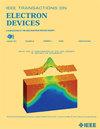High-Resistivity Substrates in 22-nm FD-SOI—Part II: Impact on mm-Wave SPDT Performance
IF 3.2
2区 工程技术
Q2 ENGINEERING, ELECTRICAL & ELECTRONIC
引用次数: 0
Abstract
This article delves into the detailed design and performance analysis of a mm-wave single-pole double-throw (SPDT) switch, fabricated in the GlobalFoundries 22-nm fully depleted silicon-on-insulator (FD-SOI) process on several types on silicon wafer, from standard-resistivity22nm fd - so2中高电阻率衬底-第二部分:对毫米波SPDT性能的影响
本文深入研究了一种毫米波单极双掷(SPDT)开关的详细设计和性能分析,该开关采用GlobalFoundries公司的22纳米全贫绝缘体上硅(FD-SOI)工艺,在几种类型的硅片上制造,从标准电阻率$10~ $ Omega \cdot $ cm到高电阻率$ 620 ~ $ Omega \cdot $ cm变体。基于第一部分的基本结果,本工作研究了SPDT开关布局中衬底引入的特定阻抗路径和寄生效应,并强调了通过采用同时具有高界面和体电阻率值的硅衬底可以实现的射频(RF)性能增益。对等效阻抗路径进行了详细的提取,以量化体电阻率和界面电阻率的贡献,特别强调了这些寄生对插入损耗(IL)和信号完整性影响最大的布局区域。电磁(EM)仿真用于精确建模开关布局,从而能够对耦合机制进行全面分析。进一步探讨了优化的高电阻率(HR)衬底和界面钝化技术的影响,显示了它们在减轻毫米波频率下寄生损耗方面的关键作用。这项工作为高频电路模块中基片引起的性能下降提供了有价值的见解,并提出了一种全面的建模方法来预测和减轻这些影响。
本文章由计算机程序翻译,如有差异,请以英文原文为准。
求助全文
约1分钟内获得全文
求助全文
来源期刊

IEEE Transactions on Electron Devices
工程技术-工程:电子与电气
CiteScore
5.80
自引率
16.10%
发文量
937
审稿时长
3.8 months
期刊介绍:
IEEE Transactions on Electron Devices publishes original and significant contributions relating to the theory, modeling, design, performance and reliability of electron and ion integrated circuit devices and interconnects, involving insulators, metals, organic materials, micro-plasmas, semiconductors, quantum-effect structures, vacuum devices, and emerging materials with applications in bioelectronics, biomedical electronics, computation, communications, displays, microelectromechanics, imaging, micro-actuators, nanoelectronics, optoelectronics, photovoltaics, power ICs and micro-sensors. Tutorial and review papers on these subjects are also published and occasional special issues appear to present a collection of papers which treat particular areas in more depth and breadth.
 求助内容:
求助内容: 应助结果提醒方式:
应助结果提醒方式:


